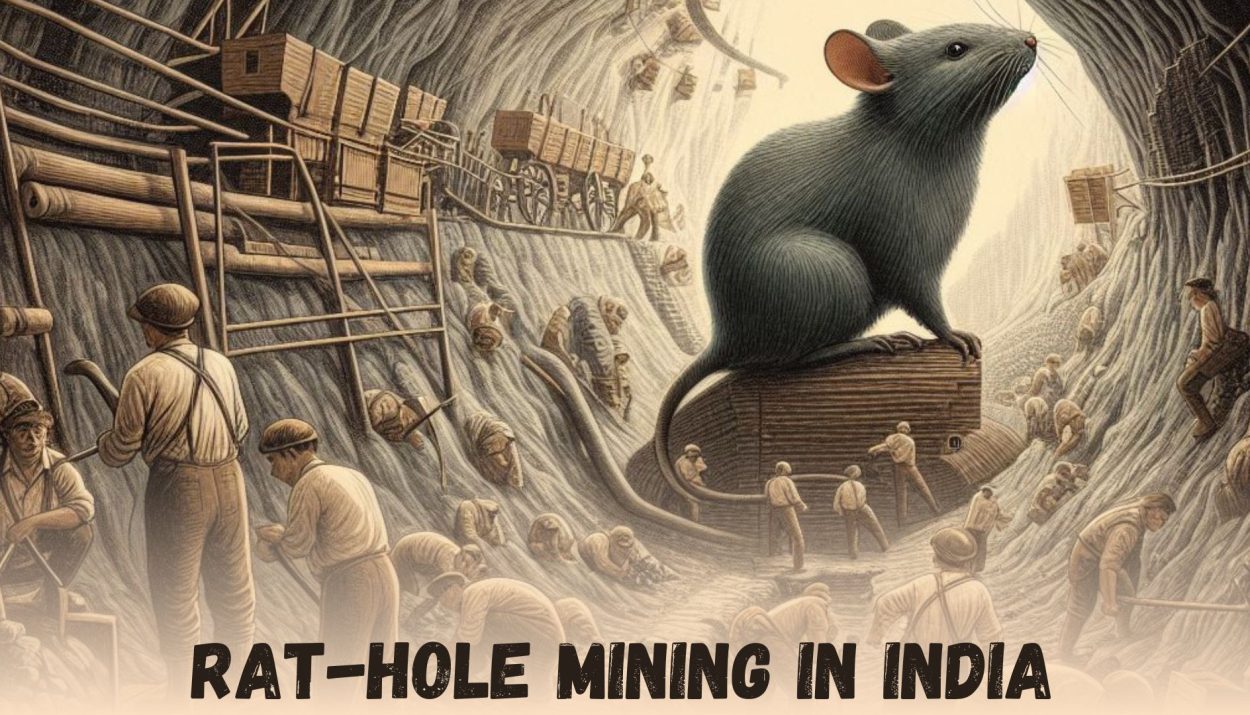Rat-hole mining, a distinctive and controversial practice prevalent in certain regions of India, is explored in ‘Understanding Rat-Hole Mining in India: Examples and Implications.’ This examination provides insights into the complexities of the mining method, shedding light on its various facets and consequences. We will delve into the intricacies of rat hole mining, exploring its definition, methods, and specific examples that highlight its presence in the Indian mining landscape.
Rat Hole Mining
Rat hole mining is an unconventional and hazardous method of extracting minerals, primarily coal, involving the excavation of narrow vertical holes into the ground, reminiscent of the burrows created by rodents.
This perilous and contentious technique is employed to extract slender coal seams, named for its resemblance to rats creating pits in the ground. The process involves narrow excavations, typically spacious enough for a single person to descend and retrieve coal. Miners use ropes or bamboo ladders to access the coal seams, employing manual labour with primitive tools like pickaxes, shovels, and baskets.
Categorized into two distinct types, rat-hole mining creates tunnels that are merely 3-4 feet deep, allowing workers to crawl in and out. In this method, miners squat while using pickaxes for coal extraction. The first type, side-cutting mining, is typically conducted on hill slopes, following a coal seam visible externally.
The second type, box-cutting, involves excavating a circular or square pit with a minimum width of 5 square meters, reaching depths of up to 400 feet. Miners descend using makeshift cranes or rope-and-bamboo ladders and, upon discovering the coal seam, proceed to dig horizontally. The resulting tunnels extend in various directions from the pit’s edge, resembling the tentacles of an octopus.

The practice was extensively utilized in the northeastern state of Meghalaya. These mines are commonly unregulated, lacking essential safety measures such as adequate ventilation, structural support, or proper safety gear for workers. Additionally, the mining process has the potential to induce land degradation, deforestation, and water pollution. Responding to these concerns, the National Green Tribunal instituted a ban on this practice in 2014, and this prohibition was upheld in 2015. The directive from the NGT prohibits not just rat-hole mining but also any form of “unscientific and illegal mining.” However, orders from the Tribunal have been consistently violated without any exceptions.
Cases of Rat Hole Mining in India
Rat Hole Mining in Jaintia Hills, Meghalaya: In December 2018, 15 miners were trapped in a flooded illegal rat-hole mine in Meghalaya.
Assam Mining Incident, 2022: Three coal miners lost their lives due to the suspected inhalation of toxic gases within an unauthorized rat-hole mine located in Ledo, Tinsukia district of Assam.
Uttarakhand Tunnel Rescue, 2023: A practice prohibited in India since 2014 played a crucial role in the rescue of 41 tunnel workers at the Silkyara-Barkot tunnel in Uttarakhand on November 29, 2023. Following the failure of advanced machinery in the rescue efforts, rat miners were called upon. Through manual drilling, they successfully reached the trapped workers, ultimately facilitating their escape from the collapsed tunnel. Despite the adverse effects associated with rat hole mining, this recent instance highlights its potential advantages in the context of a rescue operation.

Challenges and Controversies
Environmental Degradation:
Deforestation: Rat hole mining often involves clearing large areas of forests, contributing to deforestation and the destruction of natural habitats, resulting in the decline of diverse plant and animal species.
Water Pollution: Improper disposal of mining waste leads to water pollution, affecting aquatic life and communities reliant on these resources.
Soil Erosion: Unregulated mining practices contribute to soil erosion, impacting land fertility and exacerbating environmental degradation.
During the rainy season, water inundated the mining areas, leading to the tragic loss of numerous lives, including both employees and workers. This directive was particularly relevant to Meghalaya, where rat hole mining continued to be a prevalent method of coal extraction.
Social and Health Implications:
Child Labor and Unsafe Working Conditions: Rat hole mining is notorious for employing children in hazardous conditions, jeopardizing their health and well-being.
Read- CHILD RIGHTS AND PROTECTION
Occupational Hazards: The lack of safety measures exposes workers to the risk of accidents, respiratory issues, and other health complications.
Impact on Local Communities: Mining operations often result in the displacement of local communities, disrupting their traditional ways of life.
Poverty and Social Strain: The economic benefits of mining may not reach the affected communities, leading to increased poverty and social strain.
Regulatory Challenges:
Ineffective Regulation: Despite legal bans on rat hole mining, enforcement remains a significant challenge due to inadequate resources and corruption.
Political Interference: The nexus between politics and mining interests often hampers the stringent enforcement of regulations.
Way Forward
Rat hole mining in India necessitates a holistic and proactive approach to address the multifaceted challenges associated with this controversial practice. Strengthening the regulatory framework is paramount, with a focus on rigorous enforcement and monitoring to ensure strict adherence to existing bans and regulations. Additionally, engaging local communities in decision-making processes and providing alternative livelihood options through skill development programs can mitigate the economic dependence on rat hole mining. Embracing technological innovation is crucial, encouraging the adoption of safer and more sustainable mining technologies that minimize environmental impact and reduce reliance on hazardous manual labour.
Efforts should also be directed towards the rehabilitation and conservation of mining-affected areas, emphasizing ecosystem restoration and biodiversity conservation. Public awareness campaigns play a pivotal role in educating communities about the far-reaching consequences of rat hole mining, fostering a collective commitment to responsible resource extraction practices. By implementing these comprehensive measures, India can navigate a more sustainable path in its mining industry, balancing economic development with environmental and social responsibility.
Furthermore, a crucial aspect of the way forward involves the establishment of enhanced penalties for violations, serving as a deterrent and reinforcing the seriousness of breaching regulations. This, coupled with continuous monitoring and periodic audits, can help curb the persistence of illegal rat-hole mining activities. Government initiatives should prioritize the conservation of ecosystems and the preservation of biodiversity in regions affected by mining activities, ensuring the long-term health of these ecosystems.

Education and awareness campaigns should extend beyond local communities to include broader stakeholders, fostering a collective responsibility for sustainable mining practices. In tandem, collaborative efforts between government bodies, non-governmental organizations, and mining industry stakeholders can facilitate the development and implementation of comprehensive policies that address the root causes of rat-hole mining. Additionally, allocating resources to research and development for sustainable mining practices will contribute to long-term solutions, reducing the reliance on environmentally detrimental methods.
In conclusion, rat hole mining in India presents a complex scenario, intertwining economic necessities with environmental and social challenges. Understanding the nuances of this mining method and its consequences is crucial for policymakers, communities, and the broader public as they navigate the path towards sustainable resource extraction.
References
The unregulated, lethal and corrupt world of Meghalaya’s rat-hole mines
Uttarkashi tunnel collapse: What is rat-hole mining & how does it work?
Rat hole mining: banned practice saves 41 lives from the collapsed Uttarakhand tunnel
What is rat-hole mining, being done to rescue trapped Uttarkashi tunnel workers







